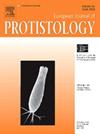Morphology, morphogenesis, and molecular phylogeny of a new brackish water ciliate, Heterodeviata longa nov. spec. (Ciliophora, Hypotrichia)
IF 1.6
2区 生物学
Q4 MICROBIOLOGY
引用次数: 0
Abstract
The morphology and morphogenesis of a new Stichotrichida species, Heterodeviata longa nov. spec., isolated from a brackish water habitat in Qingdao, China, were investigated using live observation and the protargol staining method. The new species is morphologically distinguished by possessing one buccal, three to five parabuccal and three frontal cirri, one long frontoventral row of ca. 12 cirri extending beyond mid-body, four left and two right marginal cirral rows, and two dorsal kineties: (1) left dorsal kinety bipolar, comprising 16–23 dikinetids, and with one to three caudal cirri at its rear end, while (2) right dorsal kinety comprising only two dikinetids. During morphogenesis, four frontal-ventral cirral anlagen form both in the proter and the opisthe. The parental adoral zone of membranelles remains intact and is completely inherited by the proter. The anlagen for marginal rows and the left dorsal kinety develop intrakinetally. The right dorsal kinety is generated dorsomarginally. The 18S rRNA gene sequence of the new species has a similarity of 99.6 % and 98.1 % with two other congeners. Phylogenetic analysis supported their close relationship and the monophyly of the genus Heterodeviata.
一种新的咸淡水纤毛虫,Heterodeviata longa 11 . spec.(纤毛虫目,下毛目)的形态、形态发生和分子系统发育
采用活体观察和原targol染色法,对青岛某咸水生境中一新种尾毛虫(Heterodeviata longa nov. spec)的形态和形态发生进行了研究。该新种在形态上具有1个颊卷、3至5个颊旁卷和3个额卷,1个长额腹排约12个卷,延伸至身体中部,4个左边缘卷和2个右边缘卷,以及2个背侧运动:(1)左背运动双极性,包括16-23个双动体,并在其尾部有1至3个尾卷,而(2)右背运动仅包括2个双动体。在形态发生过程中,蛋白和视肌均形成四种额-腹侧环状胶原。亲本膜片区保持完整,并完全由蛋白遗传。边缘行和左背肌的角原是相互作用的。右背运动是由背侧产生的。新种的18S rRNA基因序列与其他两个同系物的相似性分别为99.6%和98.1%。系统发育分析支持了它们的亲缘关系和异种属的单系性。
本文章由计算机程序翻译,如有差异,请以英文原文为准。
求助全文
约1分钟内获得全文
求助全文
来源期刊

European journal of protistology
生物-微生物学
CiteScore
4.60
自引率
20.70%
发文量
55
审稿时长
14.6 weeks
期刊介绍:
Articles deal with protists, unicellular organisms encountered free-living in various habitats or as parasites or used in basic research or applications. The European Journal of Protistology covers topics such as the structure and systematics of protists, their development, ecology, molecular biology and physiology. Beside publishing original articles the journal offers a forum for announcing scientific meetings. Reviews of recently published books are included as well. With its diversity of topics, the European Journal of Protistology is an essential source of information for every active protistologist and for biologists of various fields.
 求助内容:
求助内容: 应助结果提醒方式:
应助结果提醒方式:


